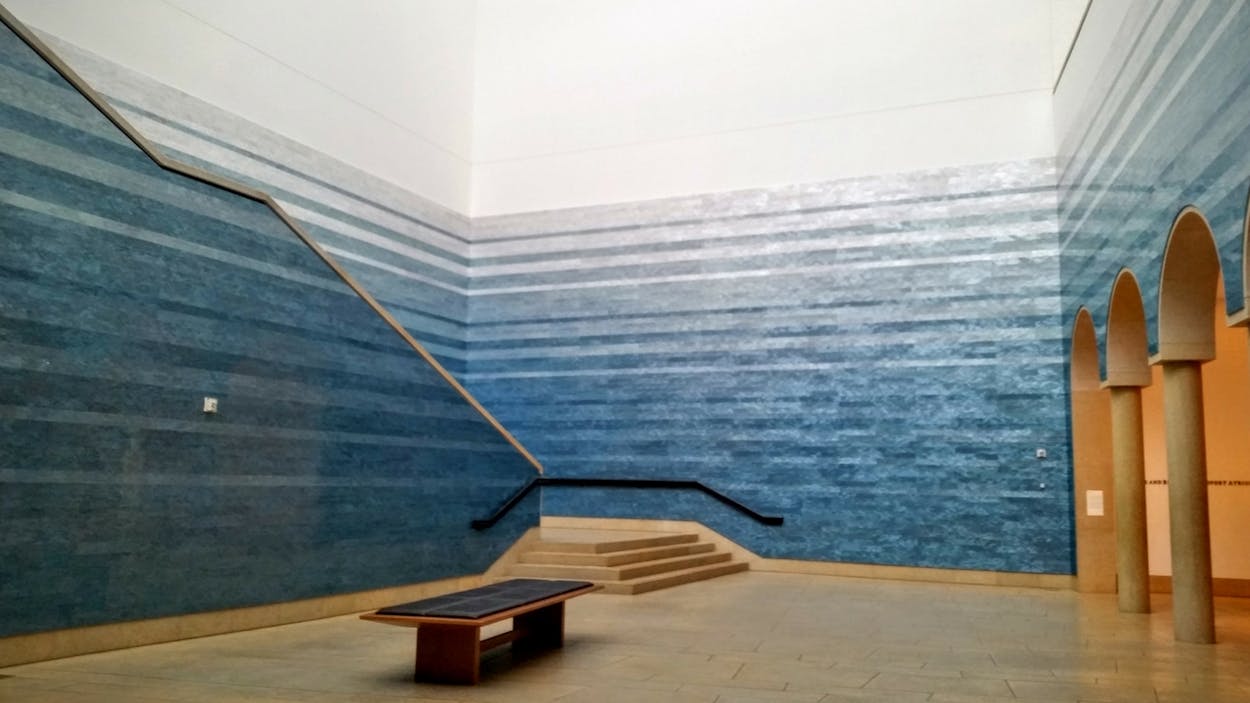AUSTIN
Blanton Museum of Art
(note: The upstairs galleries are closed for renovation but will reopen on February 12, 2017.)
Known for: A whole lot of prints and drawings (they make up a full 90 percent of the permanent collection), American and contemporary knockouts.
Crowd favorites: Teresita Fernández’s Stacked Waters (2009), the site-specific installation that ascends up the wall of the museum’s light-filled atrium; El Anatsui’s Untitled (2007); and Anselm Keiefer’s Sternenfall [Falling Stars] (1998).
Don’t overlook: The Museum Shop and Blanton Cafe, directly across from the main entrance.
Before you go: Schedule an appointment in the H-E-B Study Room and select works of art from the collection that you’d like to see up close and personal.
Get in free: Thursdays; always free if you’re 12 or younger, a museum member, or have a University of Texas ID.
On the horizon: Renovated upstairs galleries to better show off the permanent collection. Also, Ellsworth Kelly’s Austin, a chapel-like 2,715-square-foot stone structure studded with vaulted ceilings and colored glass windows that will be the artist’s first freestanding building; construction will begin after funding is raised.
From the TM archives: “The new Blanton is just a building, not a masterpiece. And that’s the point: It’s what’s inside that’s worth lingering over.” – “Around the State: The Blanton” (April 2006)
Bullock Texas State History Museum
Known for: Three floors of old, cool Texas things (from Stephen F. Austin’s desk to a Mother Hubbard saddle), the only IMAX with Laser projection system in the state.
Crowd favorites: The reconstructed hull of the seventeenth-century French sailing ship, La Belle; a 1960’s NASA Mission Control console; the original Goddess of Liberty that topped the Texas Capitol from 1888 to 1985.
Don’t overlook: Seeing Texas History: The Bob Bullock Texas State History Museum, a coffee table book featuring dozens of the museum’s prized artifacts.
Before you go: Brush up on your Lone Star history via online resources like the Texas History Timeline and the Interactive Texas Map.
Get in free: The first Sunday of every month.
From the TM archives: – “The 46-year-old O’Brien would create six 11- by 16-foot concrete panels that would serve as the exterior statement of the museum’s interior mission: to tell the story of Texas.” – John Spong’s “History in the Making” (April 2001)
Harry Ransom Center
Known for: Snagging the archives of a number of vaunted writers, artists, filmmakers, and intellectuals.
Crowd favorites: One of only five complete Gutenberg Bibles, the first photograph (produced in 1826 or 1827), Frida Kahlo’s Self-Portrait with Thorn Necklace and Hummingbird (on view through December 31, 2017).
Don’t overlook: The online collections guide, organized by area of study (everything from Texana and Travel to Human Rights and Costumes and Personal Effects).
Before you go: Read up on how to create a research account to access the collections in the second-floor reading and viewing rooms.
Get in free: Always.
From the TM archives: “An afternoon at the HRC turned into a week. I’d arrive in the morning, think of an artist, and ask for the moon. Half an hour later, I’d be holding a handwritten draft of Dylan Thomas’ Do Not Go Gentle Into That Good Night or a letter from jazz saxophonist Charlie Parker written during his court-ordered dry-out at a California mental hospital.” – John Spong’s “King’s Ransom” (October 2003)
Other standouts…
The Contemporary Austin // Both of the museum’s locations are getting facelifts: the downtown Jones Center and its rooftop are currently being expanded and are scheduled to reopen in the fall of 2016, while the sculpture park at the twelve-acre Laguna Gloria on Lake Austin is benefitting from a $9 million grant.
Mexic-Arte Museum // Founded by artists in 1984, this downtown institution celebrates both the traditional and contemporary in Mexican, Latino, and Latin American art; annual events worth nothing are the Catrina Ball, Viva La Vida, and Taste of Mexico.
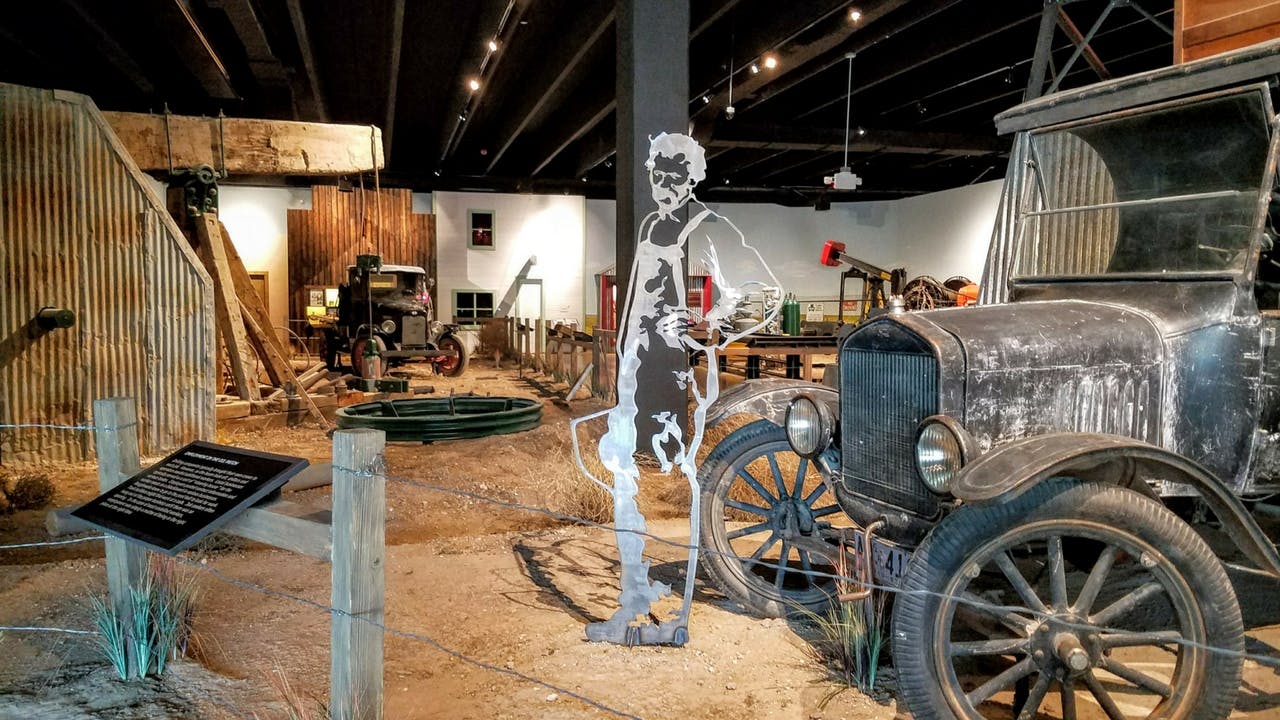
CANYON
Panhandle-Plains Historical Museum
Known for: Being the largest history museum in Texas (it has more than 285,000 square feet of exhibition space); the recently revamped Panhandle Petroleum Story, a 16,000-square-foot exhibit on the area’s oil and gas legacy.
Crowd favorites: Georgia O’Keefe’s Red Landscape, which the artist painted when she lived in Canyon; the interactive, 26-building Pioneer Town, where you can pump your own water and play a vintage piano; fine examples of Old West weaponry.
Don’t overlook: The 1877 T Anchor Ranch Headquarters, the oldest Anglo-built structure in the Panhandle, which now sits on the museum’s east lawn; the historic Texas art in the upstairs galleries.
Before you go: Fuel up at the nearby Palace Coffee and allot at least a couple of hours to wandering through the PPHM’s two maze-like levels.
Get in free: If you’re under 4, a museum member, or a West Texas A&M University faculty member, staffer, or student.
From the TM archives: “Still, I did not consciously set out to devote a sizable part of my life’s work to championing early Texas art. Obviously, I felt a connection: The museum was home to the Frank Reaugh Collection, which, today, houses an extensive archive on the artist in addition to more than 1,000 works in pastel, oil, drawing, watercolor, photographic prints, and glass-plate negatives.” – PPHM curator Michael R. Grauer’s “Texas Treasures” (October 2011)
CORPUS CHRISTI
Art Museum of South Texas
Known for: The original 1972 Philip Johnson–designed building and the 2008 addition by Ricardo Legorreta; an emphasis on fine art and craft of the Americas; a sizable bequeathing of paintings and personal documents from the late modernist Dorothy Hood.
Crowd favorites: Dorothy Hood’s Untitled #7 #100 (1980–1989), James Surls’ Seeing Through the Wind (1997), and works by Jesús Moroles.
Don’t overlook: The Dr. Clotilde P. Garcia Spanish Colonial Gallery, the museum’s first permanent exhibition, which opened in May 2016 and features Spanish Colonial masterpieces and relics.
Get in free: If you’re under 12, a museum member, or a TAMU-CC student.
From the TM archives: “The first structure was a tough act to follow, much less add to. But Ricardo Legorreta, one of Mexico’s best-known architects (together with his son, Victor) has played it smart. Their work may look a lot like its predecessor (well, except for those gleaming copper pyramids on the roof), but inside it’s replete with Legorreta hallmarks—bold colors, lots of light, unusual wall placement.” – “Around the State: Art Museum of South Texas” (October 2006)
Other standouts…
Corpus Christi Museum of Science and History // A collection of artifacts that includes everything from shipwreck salvage to decorative arts.
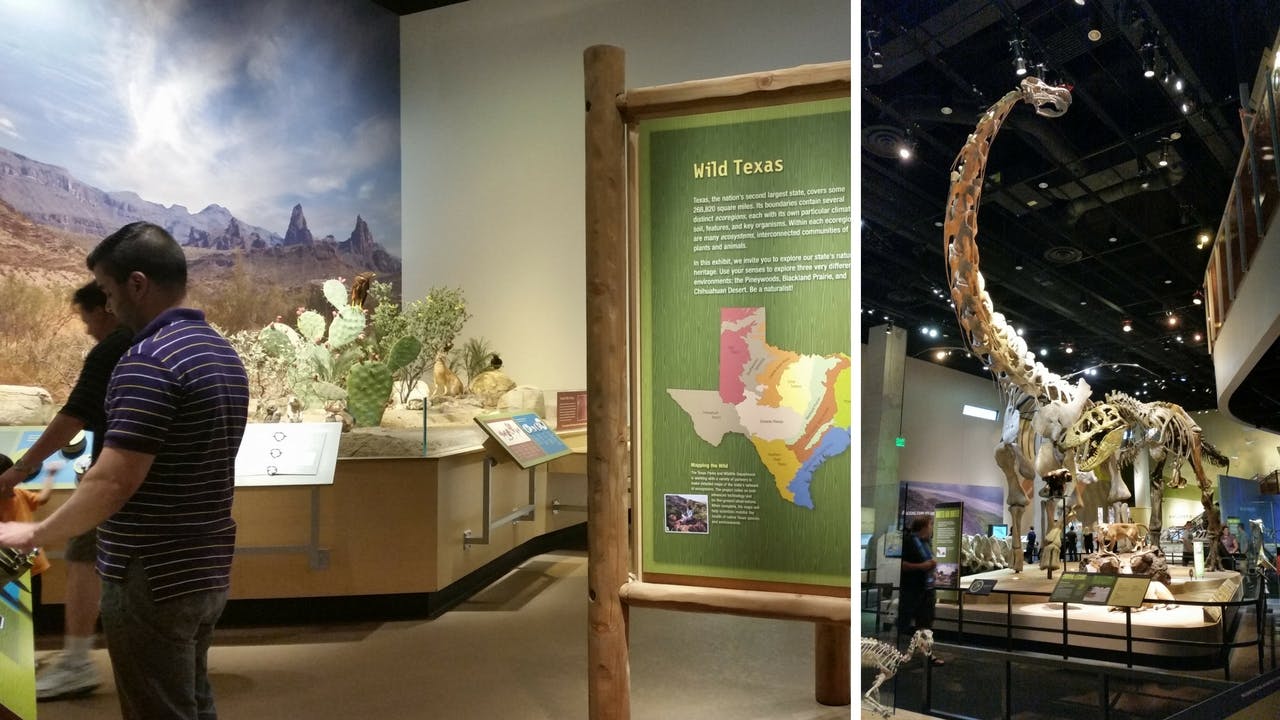
DALLAS
Dallas Museum of Art
Known for: Being the cornerstone of the nineteen-block Dallas Arts District; an encyclopedic trove of works and objects from around the globe that span five thousand years of history.
Crowd favorites: Frederic Edwin Church’s The Icebergs (1861), Jackson Pollock’s Cathedral (1947), Robert Rauschenberg’s Skyway (1964).
Don’t overlook: The Paintings Conservation Studio and Gallery where you can watch as chief conservator Mark W. Leonard and his colleagues restore and preserve priceless works.
Before you go: Search the DMA’s collection by artist/culture, materials, department, location, or even color.
Get in free: Always (admission charged for special exhibitions).
Nasher Sculpture Center
Known for: Raymond and Patsy Nasher’s impressive cache of pièces de résistance, which major museums around the world wanted for their own; the Renzo Piano building they commissioned to house the collection in their adopted hometown instead; an idyllic sculpture garden.
Crowd favorites: Henri Matisse’s Reclining Nude I (Aurora) (1907), Pablo Picasso’s Head of a Woman (Fernande) (1909), Paul Gauguin’s Tahitian Girl (c. 1896).
Don’t overlook: The self-guided visit cards and worksheets you can print out to enrich your kids’ experience of the museum.
Before you go: Check online to see what’s currently on view.
Get in free: First Saturday of the month; always if you’re under 12, a first responder, or a museum member.
From the TM archives: “The Nashers’ passion for contemporary sculpture ignited in the early sixties, when Patsy splurged on Jean Arp’s sinuous 1961 bronze Torso With Buds. She became a habitué of New York galleries, openings, and auctions, while Ray explored affinities with his own profession: ‘The sculptor is really a builder,’ Nasher once observed, and years ago he began placing sculpture in and around his own three-dimensional creations.” – Michael Ennis’s “Everybody Loves Ray” (September 2003)
Perot Museum of Nature and Science
Known for: Eleven exhibit halls that offer a deep dive into everything from being human to our expanding universe; the first complete Alamosaurus skeleton on display.
Crowd favorites: The aforementioned Alamosaurus as well as a Tyrannosaurus rex, the musical staircase, the Sports Run Exhibit (in which you can race against a cheetah or an NFL player).
Don’t overlook: The Rose Hall of Birds, which offers a bird’s-eye view of the dino hall.
Before you go: Pre-order your tickets to skip the lines (and to prevent being turned away in the event of a sellout).
Get in free: If you’re under 2, a museum member, or a K-12 educator in Texas or bordering states.
From the TM archives: “Scientists who work in museums do so for a reason. We believe there’s great value in interpreting science for the public. And dinosaurs, I think, are a portal for people to get interested in science. They fuel something within our imaginations at a primal level.” – from “The Working Life: Anthony Fiorillo, Paleontologist” (November 2011)
Other standouts…
Crow Collection of Asian Art // Like the Nashers’ repository across the street, Trammell and Margaret Crow’s serene gallery and sculpture garden, where you’ll find priceless Qing dynasty jades and Mughal-style architectural works, are a testament to their acquisitive bent and philanthropy.
Meadows Museum // Dubbed “the Prado on the prairie,” SMU’s museum houses one of the most significant hauls of Spanish art (Goyas, Mirós, Picassos) outside of Spain.
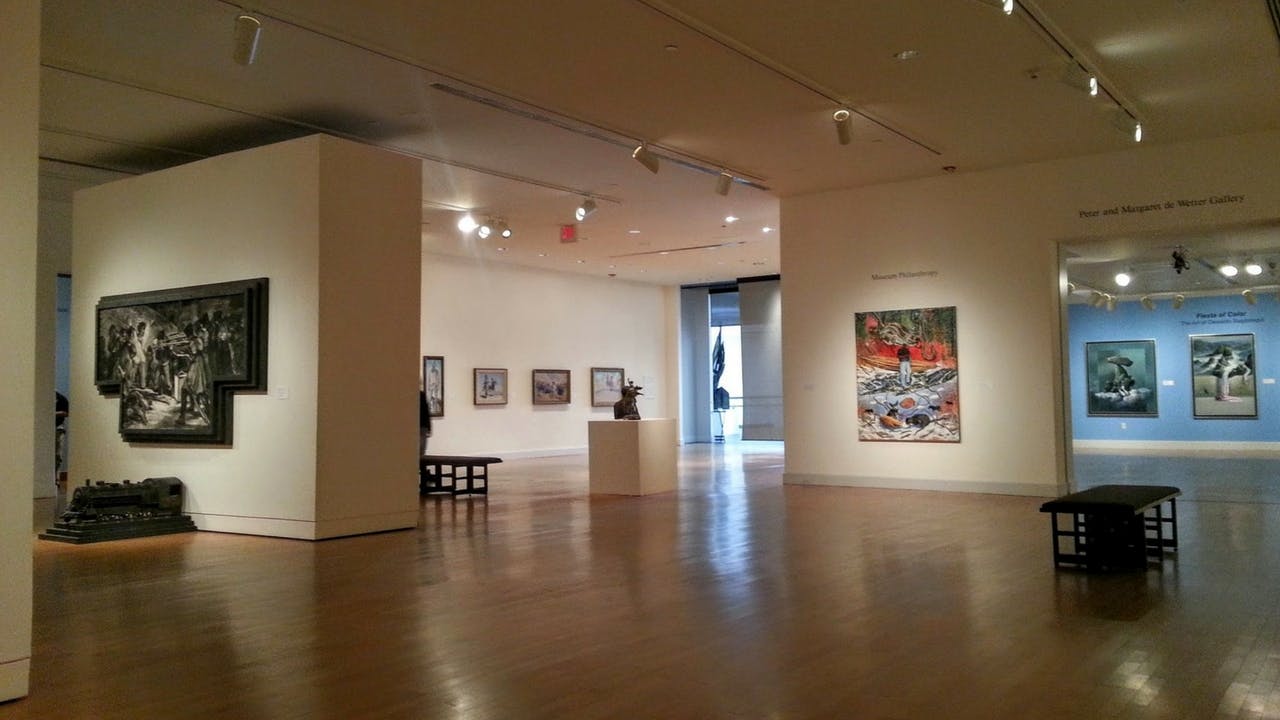
EL PASO
El Paso Museum of Art
Known for: Being the only accredited art museum within a 250-mile radius; the 59 works of European art from the Samuel H. Kress Foundation that kickstarted the museum’s launch in 1959; Colonial portraiture; European and Mexican masterworks.
Crowd favorites: Sir Anthony van Dyck’s Portrait of a Lady (c. 1620–21), works by El Paso artists like Tom Lea (he gets an entire gallery), Manuel Acosta, and Eugene Thurston.
Before you go: Enjoy an elegant lunch at Café Central, downtown’s chic bistro, just a short walk from the museum.
Get in free: Always.
Other standouts…
El Paso Museum of History // A small but mighty educational center that boasts a touch-sensitive digital wall (one of only three of its kind in the world) that takes visitors through the city’s history via more than ten thousand images and videos submitted by the public.
Stanlee and Gerald Rubin Center for the Visual Arts // Site-specific works and rotating exhibitions on the UTEP campus enliven the local contemporary art scene.
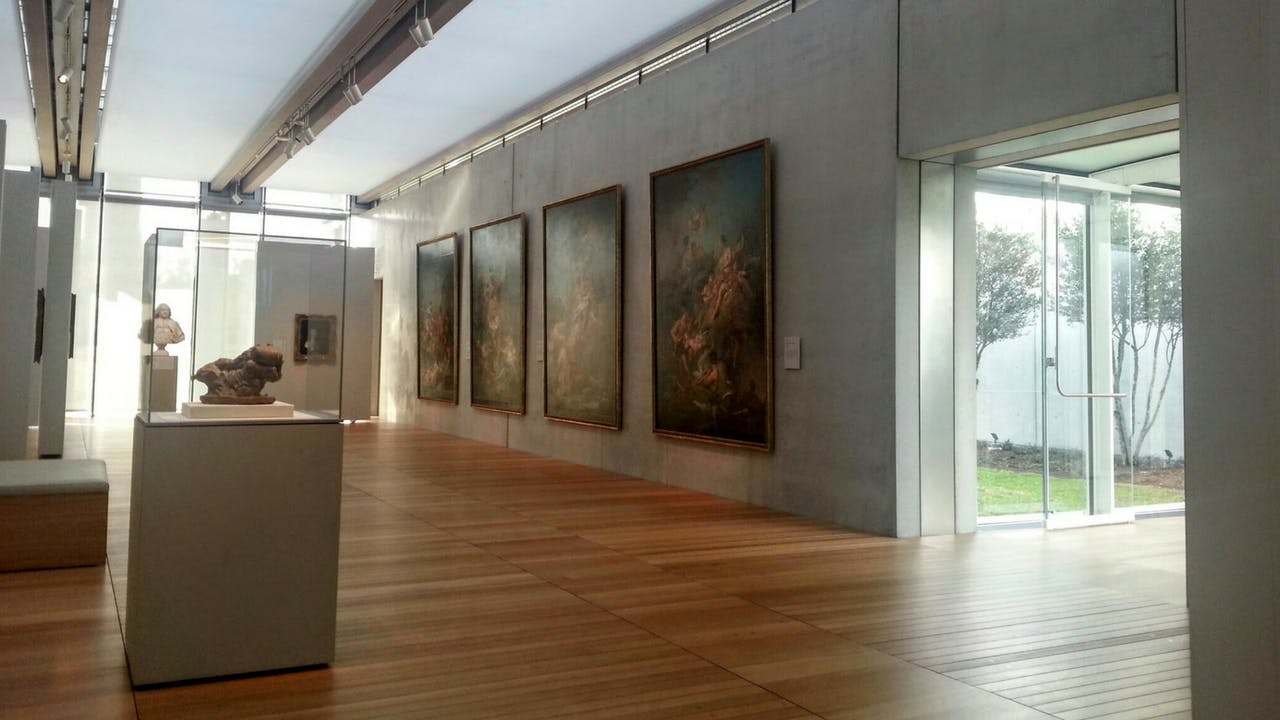
FORT WORTH
Amon Carter Museum of American Art
Known for: Founder Amon G. Carter’s beloved stash of Western paintings and bronzes by Frederic Remington and Charles M. Russell; the more than 45,000 photographic prints by 450-plus photographers.
Crowd favorites: Thomas Eakins’s Swimming (1885), Frederic S. Remington’s A Dash for the Timber (1889), Richard Avedon’s In the American West portraits.
Don’t overlook: “Texas Bird’s-Eye Views,” an online exhibit of some of the more than three hundred nineteenth- and twentieth-century maps in the museum’s collection.
Before you go: Plan to make a day of it and visit the adjacent Kimbell and Modern museums as well.
Get in free: Always.
From the TM archives: “Carter’s interest in art never strayed beyond the twin avatars of the cowboy genre, but within his narrow field he bought only the best. ‘Carter was way ahead of his contemporaries in his eye for quality,’ Stewart says, a claim substantiated by works like Remington’s landmark 1889 painting, A Dash for the Timber, a cowboy-and-Indian chase scene so cinematic that it looks like it was filmed in Todd-AO.” – from Michael Ennis’s “Amon High” (January 2002)
Kimbell Art Museum
Known for: Louis Kahn’s original vaulted 1972 building (the architect’s most famous American building) and Renzo Piano’s 2013 addition 65 yards to the west (“close enough for conversation”); a small but strong permanent collection that boasts an embarrassment of early-twentieth-century riches and antiquities (from Greek to pre-Columbian).
Crowd favorites: Caravaggio’s The Cardsharps (c. 1594), Duccio di Buoninsegna’s The Raising of Lazarus (c. 1310–11), J.M.W. Turner’s Glaucus and Scylla (1841), Michaelangelo’s first known painting, The Torment of Saint Anthony (1487).
Don’t overlook: The musical performances held in the intimate, 289-seat auditorium, known for its first-rate acoustics.
Before you go: Bring a frisbee and/or a picnic to enjoy the lawn between the Kahn Building and the Piano Pavilion.
Get in free: Always (admission charged for special exhibitions).
From the TM archives: “The international praise lavished almost immediately upon the Kimbell and its contents didn’t just elevate the architectural profile of the cultural district, it transformed the psyche of the entire state.” – Michael Ennis’s “Change of Art” (February 2013)
Modern Art Museum of Fort Worth
Known for: Tadao Ando’s glass pavilions that seemingly float on a reflecting pool; a prized assemblage of postwar art.
Crowd favorites: Martin Puryear’s Ladder for Booker T. Washington (1996), Anselm Kiefer’s Book With Wings (1992-1994), Dan Flavin’s The Diagonal of May 25, 1963 (1963).
Don’t overlook: The chance to scream, sing, clap, or stomp inside Richard Serra’s Vortex, the 67-foot-tall sculpture made of oxidizing Cor-ten steel that sits outside and makes for an artful echo chamber.
Before you go: Make a reservation for lunch or brunch (or dinner, on Fridays) at Café Modern, which has floor-to-ceiling windows and a Zen-like view of the shimmering pool outside.
Get in free: Sundays (Wednesdays are half-price); always free if you’re 12 or younger or a museum member.
From the TM archives: “There’s an empty office upstairs that we call the “war room,” where we have huge floor plans of each gallery laid out on tables. The preparators make scaled-down maquettes of each piece of art, and I move those around to figure out how they should be arranged. But even though I know the ambience of the space and the works intimately, the arrangement always changes when the art arrives and we unwrap everything.” – from “The Working Life: Andrea Karnes, Museum Curator” (October 2010)
Other standouts…
Fort Worth Museum of Science and History // Kids (and kids at heart) happily expend mental and physical energy as they learn and play their way through the DinoLabs and DinoDig, Innovation Studios, and the Cattle Raisers Museum.
National Cowgirl Museum and Hall of Fame // Located in the Will Rogers Memorial Complex, the 33,000-square-foot museum celebrates the achievements of women in the American West (from Sacagawea to Sandra Day O’Connor) and the collection includes Annie Oakley’s wedding ring and gun and Dale Evans’s Bohlin saddle.
Sid Richardson Museum // Over in Sundance Square, you’ll find the late oilman Sid Richardson’s personal collection of paintings by Western legends Frederic Remington, Charles M. Russell, and their contemporaries.
GALVESTON
The Bryan Museum
Known for: More than 70,000 Texas artifacts that Houston businessman J.P. Bryan has been stockpiling for decades.
Crowd favorites: A 1542 first edition of Cabeza de Vaca’s La Relación; a sword used to capture Santa Anna at the Battle of San Jacinto; a vast armory of rare pistols, rifles, and bowie knives.
Don’t overlook: The Renaissance Revival architecture and history of the building (formerly the Galveston Orphans’ Home, which survived the Great Storm of 1900) that was spiffed up to house the museum.
Before you go: Brush up on your Texas history and learn more about some of the museum founder’s ancestors, including James Perry and Moses Austin.
Get in free: Always if you’re 5 or younger.
From the TM archives: “The version of Texas history told by the Bryan Museum is a swashbuckling, unapologetically inspirational tale. Bryan himself has little use for the kind of warts-and-all revisionist history embraced by academics. ‘If you try to tell history, it’s exciting, it’s high adventure, it’s wonderful,’ he says.” – from Michael Hardy’s “Mr. Bryan’s Magical History Tour” (August 2015)
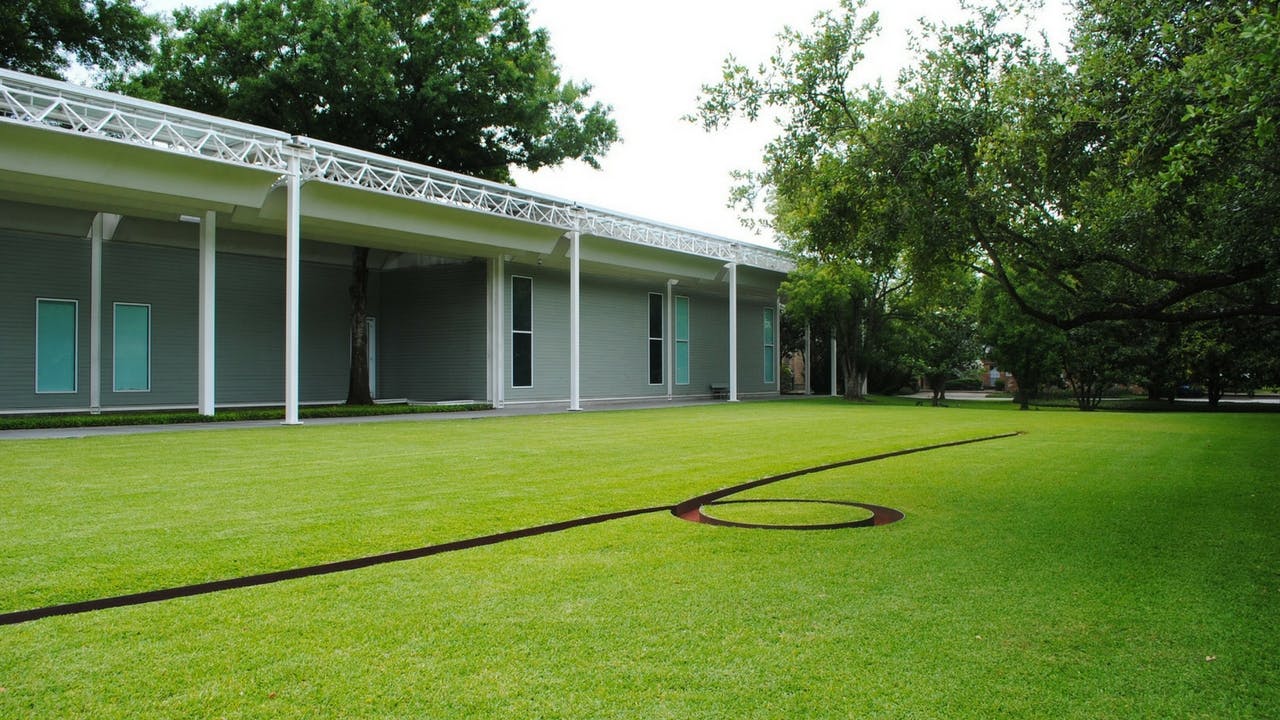
HOUSTON
Houston Museum of Natural Science
Known for: Being the state’s most-visited museum (more than two million visitors annually); having one of the largest fossil halls in the country.
Crowd favorites: The 1,500 winged beauties in the Cockrell Butterfly Center; Wyrex, the 10-foot T. Rex in the Morian Hall of Paleontology; the Geovator that takes on you on a simulated descent to the bottom of an oil well in the Wiess Energy Hall (this is Houston, after all).
Don’t overlook: The Hall of Ancient Egypt on the third floor or the gift shop.
Before you go: Plot out your #HMNSelfies.
Get in free: Thursdays from 3 to 6 (permanent exhibits only); always if you’re 2 or younger.
From the TM archives: “In 2006, the museum hired Bakker, a well-known paleontologist and one of Steven Spielberg’s advisers on “Jurassic Park,” to curate the hall in the museum’s new $85 million Duncan Family Wing. The new exhibit space dwarfs the museum’s former 6,200-square-foot fossil hall, and will be home to some 750 fossils and 60 large mounts—a mix of skeletons and precise casts.” – from Sonia Smith’s “Texas Gets Prehistoric With Two New Fossil Halls” (May 2012)
Menil Collection
Known for: Renzo Piano’s low-slung, “totally introverted” building; late patrons John and Dominique de Menil’s world-renowned (and purposefully not encyclopedic) collection of everything from tribal African masks and Byzantine artifacts to Surrealist standouts and contemporary needle movers.
Crowd favorites: Cy Twombly’s Untitled (Say Goodbye, Catullus, to the Shores of Asia Minor), René Magritte’s L’empire des lumières (The Dominion of Light), the Witnesses to a Surrealist Vision room.
Don’t overlook: The Menil’s satellite buildings (the Cy Twombly Gallery and the Dan Flavin installation at Richmond Hall), the bookstore, or Bistro Menil.
Before you go: Pack a blanket for a picnic in the park across the street, where you’ll also find a red swing hanging from the sturdiest oak tree.
Get in free: Always.
On the horizon: The Menil Drawing Institute, which will be the first freestanding facility in the U.S. designed for the exhibition and study of modern and contemporary drawings (slated to open in 2017).
From the TM archives: “Mrs. de Menil is an extraordinary collector. Many wealthy people buy art only to give it away for the tax deductions, or they ask stylish dealers to sweep together instant, high-status collections or to find paintings to match fabric swatches. But the Menil Collection grew out of a real passion for art. Mrs. de Menil found out early in her life that she had “the Eye,” an ability to see past the commonplace, the temporal, to the ineffable quality that makes something art, that makes its creator an artist.” – from Dominique Browning’s “What I Admire I Must Possess” (April 1983)
Museum of Fine Arts, Houston
Known for: A permanent collection as broad as it is deep, particularly in Renaissance, Impressionist, and post-Impressionist art as well as works from Latin America and Islamic worlds; two main gallery buildings, connected by an underground tunnel, that have a seemingly infinite number of galleries.
Crowd favorites: James Turrell’s The Light Inside, Rembrandt’s Portrait of a Young Woman, the MFAH Films series, the Cullen Sculpture Garden.
Don’t overlook: The Hirsch Library, where you can peruse the same books and periodicals on visual arts that the museum’s curators reference (always free); the Bayou Bend Collection and Gardens on fourteen acres of Houston’s historic River Oaks neighborhood.
Before you go: Follow the @MFAH on Twitter to see which food trucks will be onsite the day of your visit.
Get in free: Thursdays (open till 9 p.m.); always if you’re 12 or younger.
On the horizon: A $450 million expansion that includes a 164,000-square-foot building for twentieth- and twenty-first century art, a new 80,000-square-foot space for the Glassell School of Art, and a conservation center (expected to be completed by 2019).
From the TM archives: “‘I’ve landed the best job in the world,’ Tinterow gushed to the New York Times. ‘It’s a matchless combination: a committed board, a passionate audience, a fine collection and an institution with the third-largest endowment in the country.’” – from Sonia Smith’s “MFAH Lands Star Director from Met” (December 2011)
Other standouts…
Include the Contemporary Arts Museum Houston, the Health Museum, the Houston Center for Contemporary Craft, Rice University Art Gallery, and really too many others to list here, so check out our Houston Museum District Trip Guide and consult the official Museum District website.
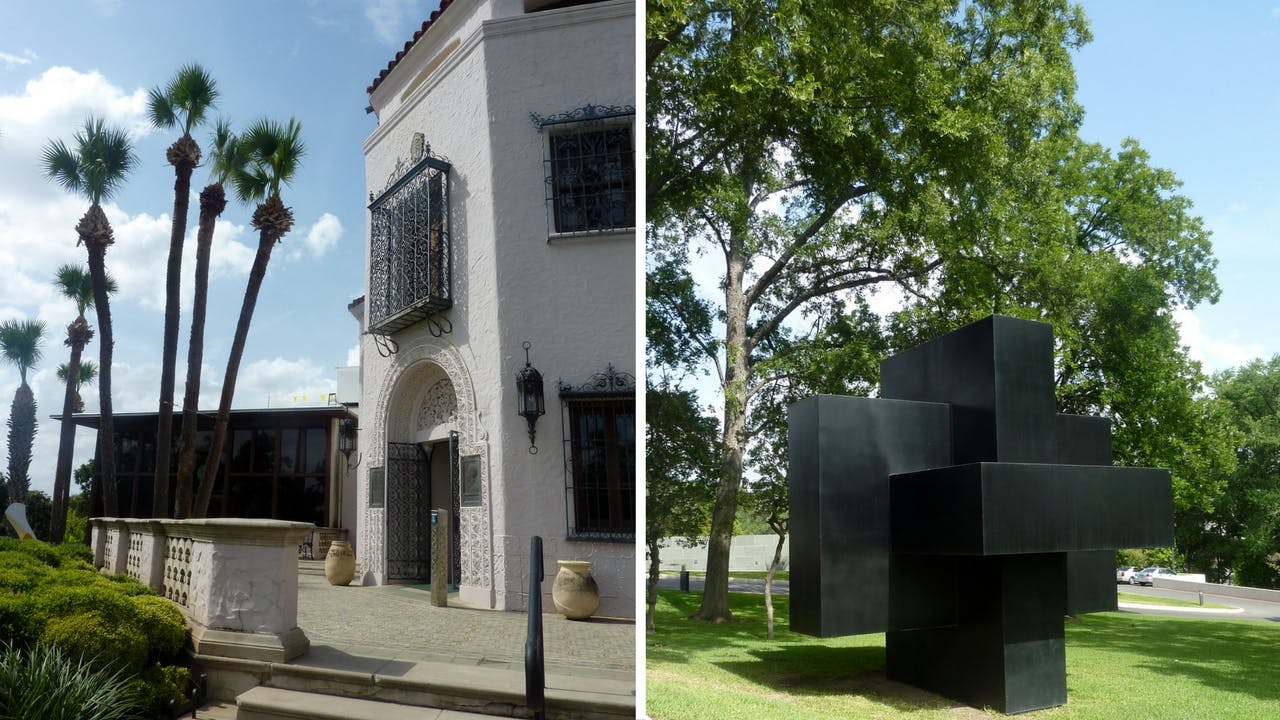
SAN ANTONIO
McNay Art Museum
Known for: Being the first modern art museum in Texas (it opened in 1954); the juxtaposition of founder Marion Koogler McNay’s Spanish Colonial Revival mansion-turned-museum and the unapologetically modern addition, added in 2008; a rapidly growing collection of twentieth-century sculpture, op art, and American Modernist gems.
Crowd favorites: Pablo Picasso’s Guitar and Wine Glass (1912), Joel Shapiro’s Untitled (2000), Robert Rauschenberg’s Rush #5 from the Cloister Series (1980), Alexander Calder’s Standing Mobile (c. 1940).
Don’t overlook: The Tobin Collection of Theatre Arts, “a visual history of scene design from the Renaissance to the present.”
Before you go: Consider hopping on VIA Metropolitan Transit’s new VIVA Culture route, which runs between the McNay and several other cultural attractions, including the San Antonio Museum of Art, the Witte Museum, the Blue Star Arts Complex, the San Antonio Zoo, and the Pearl.
Get in free: Thursdays from 4 to 9 and first Sundays of the month; always if you’re 19 or younger or a museum member.
From the TM archives: “But unlike the previous seven additions, the latest is no mere tweak: The 45,000-square-foot Jane and Arthur Stieren Center for Exhibitions, which nearly doubles the McNay’s size, is a profile-changing improvement that signals a new era for the 54-year-old institution.” – from “A Modern Addition” (June 2008)
San Antonio Museum of Art
(note: The European galleries, Skybridge, and Luby Courtyard are closed for renovation but will reopen in spring 2017.)
Known for: One of the largest collections of ancient Mediterranean works in the world; major gifts of Latin American folk art and Asian objects, particularly Chinese ceramics; direct access from the Museum Reach of the River Walk.
Crowd favorites: José Clemente Orozco’s The Martyrdom of St. Stephen (c. 1946), Luis Cruz Azaceta’s Oklahoma 4 (1994), Chinese dishes from the Liao Dynasty (916–1125 AD).
Don’t overlook: The latest list of the museum’s recent acquisitions.
Before you go: Grab a bite to eat at one of the restaurants at the nearby Pearl complex, then walk five minutes along the River Walk to the museum.
Get in free: Tuesdays from 4 to 9 and Sundays; always if you’re 12 or younger or a museum member.
On the horizon: Renovations are underway to double the size of the fourth-floor European galleries, refresh the auditorium and restrooms, install new roofs, and build a new restaurant.
Witte Museum
Known for: Dating to 1926 and having a prime River Walk location near Brackenridge Park; permanent and interactive exhibits and historic structures that illuminate natural history, science, and South Texas history via some 200,000 artifacts donated by South Texans themselves (it’s been called “the attic of South Texas”).
Crowd favorites: The annual exhibit of elaborately beaded Fiesta gowns, the South Texas Heritage Center, a taxidermied jaguar.
Don’t overlook: The Serenity Floor in the H-E-B Body Adventure exhibit, where you can meditate, play melodic drums, or otherwise chill out as you look out onto the San Antonio River.
Get in free: Tuesdays from 3 to 8; always if you’re 3 or younger.
On the horizon: The “New Witte,” a $100 million expansion project is set to open in spring 2017 and will include an additional 100,000 square feet of space, a new Paleontology Gallery, and an aqueduct inspired by the historic Acequia Madre built by mission Indians.
From the TM archives: “In 1926 Alice Woodley presented San Antonio’s Witte Museum with Sallie Tate’s belongings, which today are among the few artifacts of Texas slavery in the state’s museums. Woodley told the Witte that the meager possessions had all been treasured by Sallie Tate, who lived to be nearly one hundred years old.” – from Lonn Taylor’s “Artifact: Sallie Tate’s Emancipation Dress” (April 2014)
Other standouts…
Blue Star Contemporary Art // The city’s dynamic incubator of contemporary art hosts more than twenty exhibits each year.
Institute of Texan Cultures // Diversity is more than a buzzword at UTSA’s repository of artifacts and educational exhibits, which highlight some twenty-five ethnic groups who have settled in and shaped Texas.
- More About:
- Art
- San Antonio
- Houston
- Galveston
- Fort Worth
- El Paso
- Dallas
- Corpus Christi
- Canyon
- Austin

